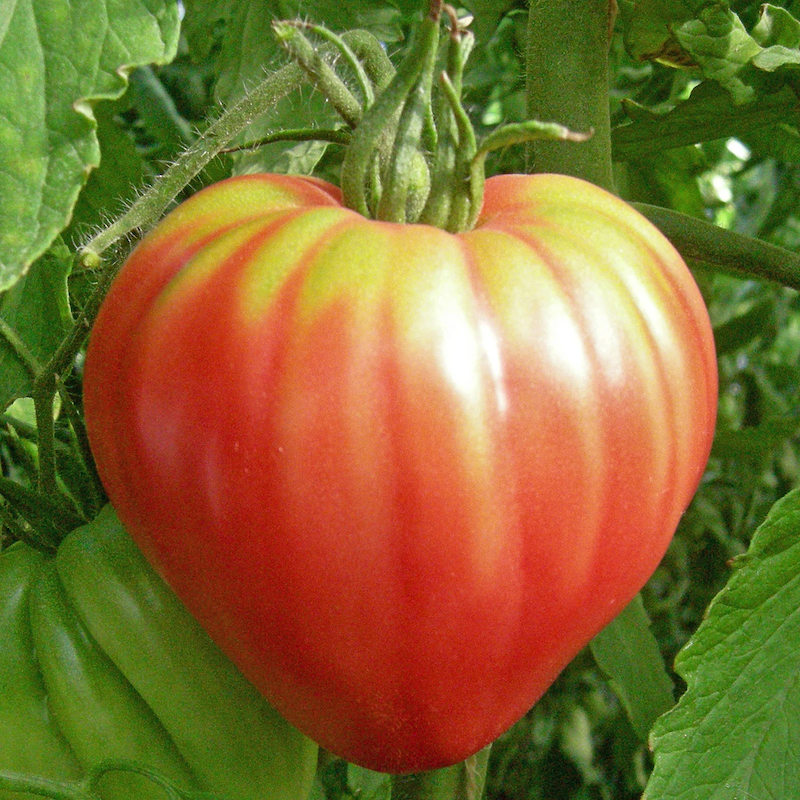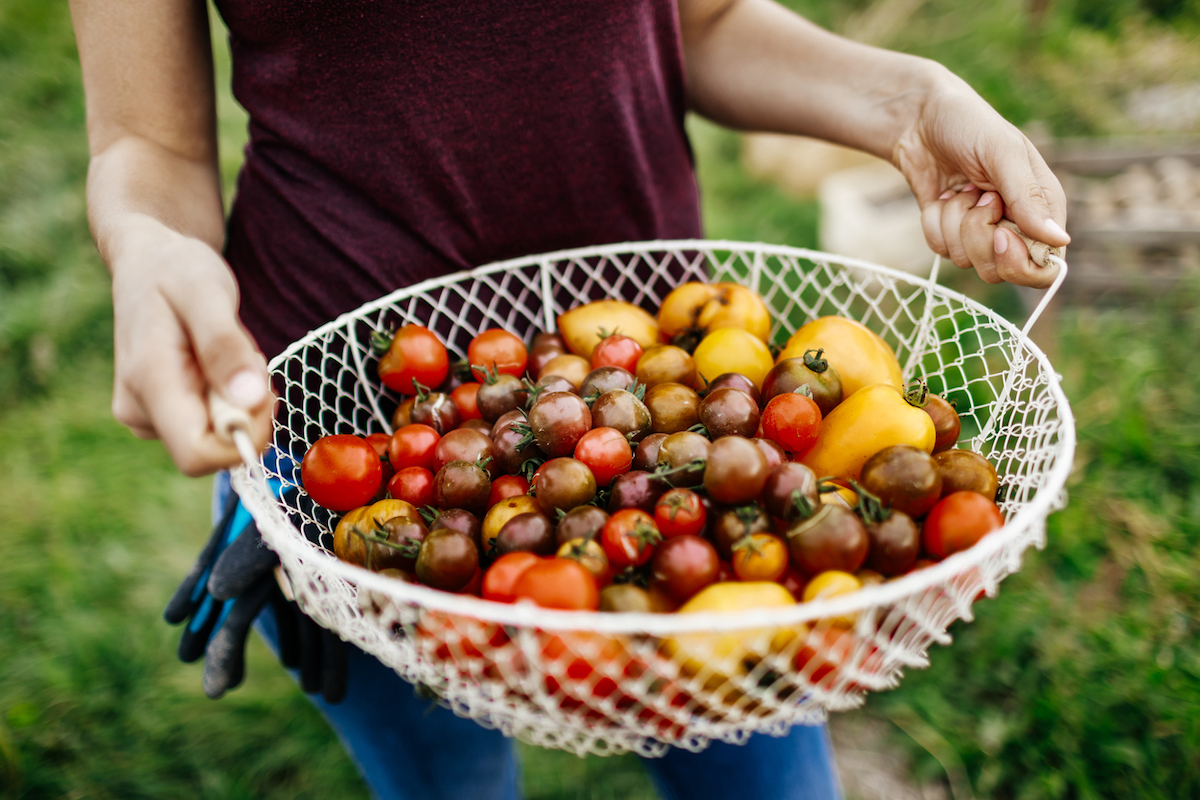We may earn revenue from the products available on this page and participate in affiliate programs. Learn More ›
Tomatoes are one of the most popular food plants grown in home gardens in the U.S. and around the world, and there are many types of tomatoes available to suit varied climates and personal tastes. According to a survey by the National Gardening Association, 86 percent of home gardeners grow this tropical South American fruit.
The tomato is popular due to its culinary versatility, but no store-bought tomato ever tasted as good as vine-ripened, homegrown tomatoes plucked from a backyard garden at the peak of ripeness. Adding to their appeal, almost all types of tomato plants are easy to grow and produce abundant yields in a small amount of real estate. Here are eight types of tomatoes gardeners can grow and harvest at home.
1. Globe Tomatoes

One of the most uniform tomato varieties in size and shape, globe tomatoes include popular cultivars Better Boy, Celebrity, Rutgers, and Early Girl. Often grown commercially because their thick skin helps them withstand shipping, storing, and handling, the medium size and uniform rounded form of globe tomatoes make them a top selection for slicing.
Tasty when fresh, they’re equally suitable for canning, juicing, and cooking. Globe tomatoes offer a mild flavor that complements many dishes. Most are red, but yellow and green varieties also are available. This round tomato rarely splits and the plants are known for producing heavy yields on vigorous vines.
Best For: Slice globe tomatoes to eat in sandwiches, salads, or burgers.
Our Recommendation: Early Girl Hybrid at Burpee Seeds for $5.95.
This variety produces good quality fruit on sturdy vines, with heavy yields of round red tomatoes.
RELATED: What Equipment Do I Need to Can My Garden’s Bounty?
2. Beefsteak Tomatoes

For a larger tomato that really holds its shape when sliced, the Beefsteak tomato offers a hefty (1-plus pound) and flavorful option. These meaty and juicy tomatoes are among the biggest. Because they have a thin skin and a short shelf life, they are rarely available commercially, but remain a perennial backyard garden favorite.
Familiar cultivars include Beefsteak, Big Boy, Beefmaster, Brandywine, and Cherokee Purple. Slightly flattened, lobed fruit grows on plants that can reach 6 feet tall. These tomato plant types can benefit from staking, trellising, or caging—as well as from periodic fertilizing. All varieties are susceptible to garden pests. They are high-yielding, but late-maturing plants.
Best For: An excellent choice for sandwiches and burgers because their beefy flesh holds its shape; they’re also delicious when eaten by themselves.
Our Recommendation: Burpee Steakhouse Hybrid at Amazon for $8.68.
Burpee’s Beefsteak hybrid tomatoes mature a few days earlier than average and are heavy producers of large, sturdy plants with an abundance of tomatoes with great flavor.
3. Cherry Tomatoes

If you’re looking for a bite-size tomato you can snack on without all the mess of slicing, choose one of the tomato types that’s smaller than a golf ball. Fast-growing cherry tomatoes produce clusters of small round, oblong, or pear-shaped fruit in colors of red, yellow, orange, and purple. Most are under an inch in diameter, with flavor ranging from mild and sweet to tangy.
Popular cherry tomato cultivars include Sweet 100, Super Sweet 100, Sweet Million, Black Cherry, and Midnight Snack. Many varieties are well suited to container gardening, but they can also be planted in the garden once all danger of frost has passed.
Best For: Great for snacking, grilling, salads, hors d’oeuvres, and shish kebobs.
Our Recommendation: Burpee Super Sweet 100 Hybrid at Amazon for $7.82.
These seeds grow into plants that produce strings of bite-sized, sugary-sweet cherry tomatoes that are the first to ripen and will continue to produce until frost.
RELATED: Pruning Tomato Plants: 6 Mistakes Most First-Time Gardeners Make
4. Plum Tomatoes

Slightly bigger than cherry tomatoes at 2 to 2½ inches, plum tomatoes are easy to distinguish by their ovoid shape. These firm, solid little tomatoes have been selectively bred to make tomato sauces, particularly for classic Italian recipes, with solid pulp and skin and seeds that are easy to remove. For this reason, they’re also known as processing tomatoes or paste tomatoes.
Since they’re less juicy, plum tomatoes also work well on pizza and as sun-dried tomatoes. The Roma may be the best-known example of these kinds of tomatoes, but other plum cultivars include Juliet, Supremo, Amish Paste, Big Mama, and Orange Banana.
Best For: Specifically bred for canning and making thick sauces and paste; they also store well.
Our Recommendation: Big Mama Hybrid at Burpee Seeds for $6.45.
The plum-shaped fruit is super meaty and grows to about 3 by 5 inches to make plenty of sauce for canning.
5. Oxheart Tomatoes

Like the Beefsteak tomato, Oxheart tomatoes are large and meaty, typically weighing at least a pound. The biggest difference is their shape. Oxhearts have a tapered bottom to form a heart shape. Another difference is that Oxheart tomatoes don’t have lobes. Instead, they look more like a globe tomato with an elongated point at the bottom. Most are red or pink, but some varieties are yellow, orange, green, or purple.
Different types of tomatoes in this category can have flavor ranging from acidic to savory to slightly sweet. Common cultivars of this mid- to late-season producer include Yellow Oxheart, Hungarian Heart, Livingston’s Giant Oxheart, and Cour di Bue.
Best For: Much like the Beefsteak, the large, meaty Oxheart tomato is best for slicing, but can also be used for stuffing and canning.
Our Recommendation: Ohio Heirloom Seeds Pink Oxheart at Amazon for $4.69.
This heirloom variety produces an abundance of large, sweet, red, heart-shaped tomatoes.
6. Heirloom Tomatoes

The category of heirloom tomatoes encompasses old-fashioned varieties—typically open-pollinated by pollinators such as bees—that have been passed down from one generation to the next. Heirloom tomatoes should breed true for at least two generations, or 40 to 50 years, although many are nearly identical to their ancestors of more than 100 years old.
While heirloom tomatoes often taste better, they can be more susceptible to diseases and other problems. They come in all shapes, sizes, and colors. Well-known heirloom choices include Cherokee Purple, Black Cherry, Amana Orange, Brandywine, and Chocolate Stripes.
Best For: Best enjoyed fresh, such as in a salad or sandwich, but heirloom tomatoes can also be baked.
Our Recommendation: Marde Ross & Company Pink Brandywine at Amazon for $12.99.
This plant delivers a heavy yield of flavorful, juicy heirloom tomatoes weighing up to a pound.
RELATED: Here’s Why You Should Always Plant Tomato Seedlings Sideways
7. Green Tomatoes

Many green tomatoes are simply unripe tomatoes of other types. However, there are heirloom cultivars that are green when ripe. Usually less acidic than red tomatoes, they often have a sweet-tart, tangy flavor that works well in salads. They’re a good source of vitamins A and C, as well as potassium. Familiar cultivars of green tomatoes include German Greens, Green Zebras, Cherokee Green, and Green Tiger.
Tomatoes that are green because they are not yet ripe are tart, acidic, crunchy, and less juicy than their ripened relatives. They can be stored until ripe, if preferred. Unripe green tomatoes should not be eaten raw; they’re toxic.
Best For: Unripened green tomatoes are good breaded and fried or baked in dishes, used in salsas and chutneys, and sauce, while ripe green tomatoes are good in salads and salsas.
Our Recommendation: Gardeners Basics Green Zebra at Amazon for $5.95.
These heirloom seeds will grow true, producing a high yield of chartreuse fruits with lime-green stripes that hold a rich, sweet flavor with a sharp bite and a subtle lemon-lime taste.
8. Specialty Tomatoes

Specialty tomatoes add pizzazz to a meal with their eye-catching colors, unusual shapes, and exotic flavors. Officially defined as smaller snacking types, there are different kinds of tomatoes included in this category—and they come in a multitude of shapes and colors. Most popular are the grape, cherub, and cherry sizes, but not all cherry tomatoes are specialty tomatoes. While specialty tomatoes are often thought of as small snackers, there are Beefsteak varieties in this category as well.
The key to a specialty tomato is flavor, followed closely by color, texture, aroma, and year-round availability, although buying local and organic specialty tomatoes also is an important trend. Recognizable cultivars include Black Krim, Purple Calabash, Japanese Black Trifele, Mini San Marzano, and RedRoyals Sweet Cherry Tomatoes on the Vine.
Best For: Most popular for snacking, although they can also be used in salads and sandwiches.
Our Recommendation: Seed Needs Rainbow Blend on Amazon for $7.99.
Variety is one element that makes specialty tomatoes desirable, so this blend of colors, flavors, and shapes offers an assortment of unusual and tasty treats.
The prices listed here are accurate as of the last update on 2/13/23.


